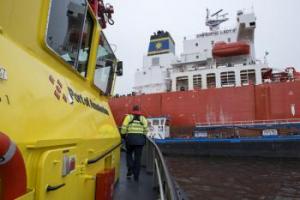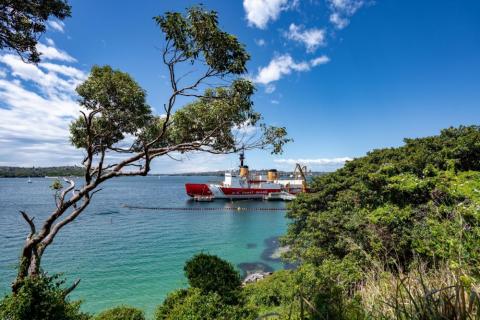Harbour Master
Harbour Masters
Worldwide there are approximately 3,000 merchant ports and the work of the Harbour Master can vary widely from country to country and from port to port even within the same country.


On 15 December the United States’ only operational heavy icebreaker, the. Coast Guard Cutter Polar Star (WAGB 10), made a scheduled port call at Chowder Bay, Australia.
Polar Star’s Chowder Bay port call was part of the vessel’s annual passage to Antarctica where they will support Operation Deep Freeze, a joint military service mission to resupply the United States Antarctic stations of the National Science Foundation, the lead agency for the United States Antarctic Program (USAP).
Twenty-six passages to Antarctica
This year (2022) marks Polar Star’s 26th voyage to Antarctica. Every year, a joint and total force team work together to complete a successful Operation Deep Freeze season. Military members from the US Air Force, Army, Coast Guard, and Navy work together through Joint Task Force-Support Forces Antarctica to continue the tradition of providing US military support. Operation Deep Freeze works closely with other Antarctic programs to include those of Australia, New Zealand, and Italy, as well as those Nations’ respective defence forces.
Captain Keith Ropella, Polar Star’s CO commented: ‘It is an honour to carry out this historic and unique mission alongside the National Science Foundation and United States Antarctic Program, in conjunction with the Joint Task Force-Support Forces Antarctica.
‘Our crew’s hard work and sacrifice ensure the success of the Polar Star’s contributions to the Operation Deep Freeze mission.’
Polar Star provides heavy icebreaking capabilities to facilitate sealift, seaport access, bulk fuel supply, and port cargo handling for three US research stations in Antarctica with McMurdo Station being the largest.
Polar Star’s ice breaking capabilities enable the safe delivery of critical supplies to sustain USAP’s year-round operations and support international partnership in the harsh Antarctic environment. It’s vitally important that the US maintains a maritime domain presence in Antarctica to protect uninhibited international access to the region. A Coast Guard heavy polar icebreaker has provided this capability for more than 30 years.
Operation Deep Freeze
Operation Deep Freeze is one of the more challenging US military peacetime missions due to the harsh environment in which it is conducted. Antarctica is the coldest, windiest, most inhospitable continent on the globe, and each trip requires careful planning and coordination. US military service members are trained and ready to support this vital mission despite the austere environment.
To quote Lieutenant Commander Benjamin Litts, Polar Star’s operations officer: ‘The Polar Star’s crew receives unique and specialized icebreaking training to ensure they are properly equipped to carry out this vital mission. The success of U S missions in the Polar Regions remains a top priority for the Coast Guard.’
Polar Star is the United States’ only asset capable of providing access to both Polar Regions. It is a 399ft loa heavy polar icebreaker commissioned in 1976, of 11,000 displacement tons, 84ft wide, with a 34 foot draft. The six diesel and three gas turbine engines produce up to 75,000 horsepower.
Picture caption and credit
Coast Guard Cutter Polar Star (WAGB 10) moored at a fuel pier in Sydney, 12 December. The icebreaker made a one-night logistics stop in Sydney to refuel before continuing passage to Antarctica in support of Operation Deep Freeze.
(US Coast Guard photo by Petty Officer 3rd Class Aidan Cooney.
USCG ©.
The International Harbour Masters Association (IHMA) and the Port of Rotterdam Authority are pleased to announce the 15th International Harbour Masters Association Congress, to be held from 09–12 June 2026 at Theater Zuidplein in Rotterdam.
Naresh Sewnath, Senior Harbour Master at Transnet National Ports Authority (TNPA) in South Africa’s Port of Durban, began his maritime career back in 1988. He started out as a cadet with TNPA (then known as South African Transport Services (SATS).